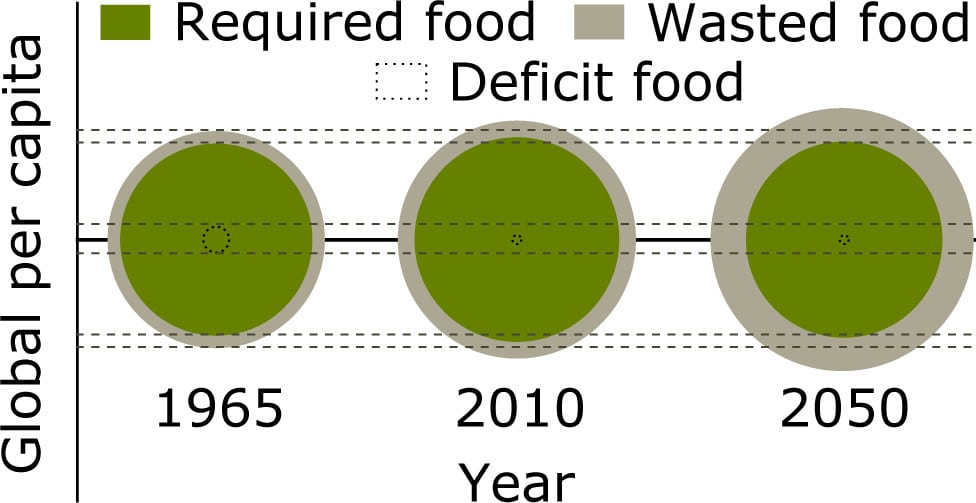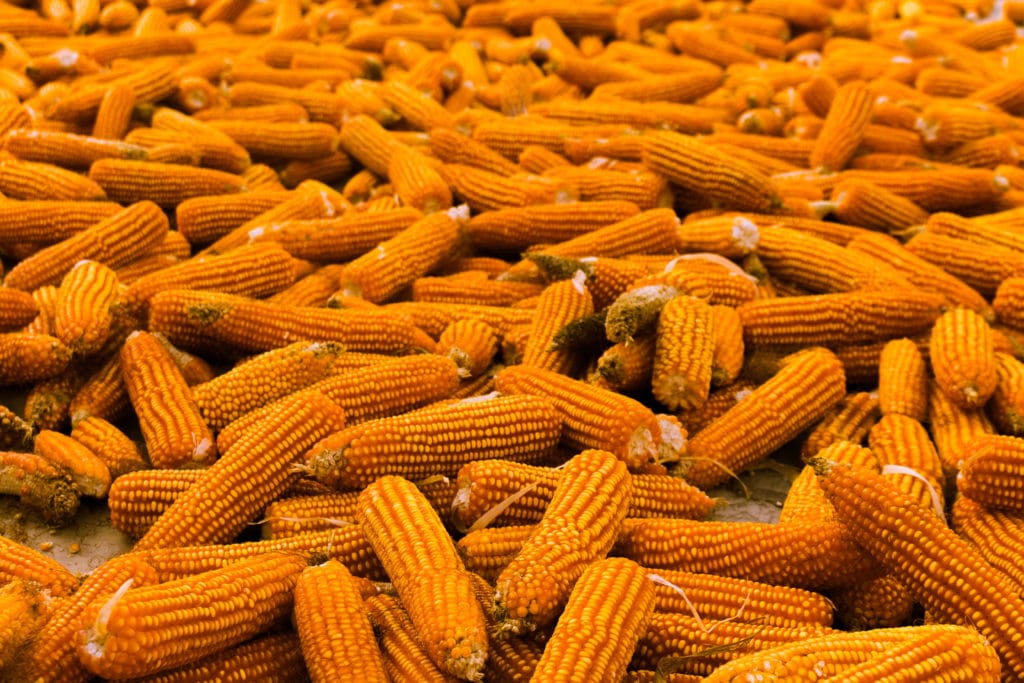Food surplus is when food availability and stock exceeds the demand, largely driven by global overproduction, and contributes towards eventual food waste and to an extent, climate change.
—-
Definition of Food Surplus
Food surplus occurs when the supply, availability and nutritional requirements of food exceeds the demand for it, and can take place at every stage of the supply chain from farms to households. Food surplus leads to either edible food and other products left unsold at supermarkets or restaurants, or piling up in farms and storages, ultimately resulting in food waste and loss.
Food surplus is not necessarily food waste, but rather a proxy for it. It can be defined as the step before food waste, where producers and consumers consciously and actively discard food. Aside from its large role towards eventual food waste, food surplus may additionally contribute to overeating – mostly in developed countries, often resulting in an overweight and obese population.
While some food waste is unavoidable (with even some not compostable), we have the ability to reduce surplus as a path to tackle food waste and its impacts on the environment and climate change.
Causes of Food Surplus
Overproduction
With the global population set to soar up to nearly 10 billion by 2050, along with changing diets, the demand for food is expected to skyrocket, with some estimates projected to increase by 60%–110% between 2005 and 2050.
To meet this rapidly increasing demand, the world’s farming industries have adopted intensive farming methods that are capable of producing large quantities of food. Since 1961, food supply per capita has grown more than 30%, according to the 2020 IPCC Special Report on climate change.
Free market economies operating in the US and EU for example have encouraged agricultural production to increase economic growth and protect food security via subsidies. This provides farmers and the industry the means to operate mass production and to produce food at lower prices per yield. Mass production is also preferred as food producers may find it difficult to estimate the quality of food to grow, and provide them with security when taking account of seasonal demands and potential changes and cancellation of large orders.
As mentioned earlier, food surplus can occur anywhere in the supply chain, including restaurants and food services. According to a 2017 research in which more than 1,200 kitchens across over 20 countries were monitored, 13 million+ pounds of food waste were generated. Half of that staggering waste was directly caused by overproduction of food. In Hong Kong for example, local bakeries often over produce food that are thrown out when they are not left unsold at the end of the day, contributing to the 40% of food waste in Hong Kong landfills.
Food Imperfection and Labelling
Food retailers and services often have a surplus of food to meet consumer demand. Yet supermarkets often throw out ‘ugly’ yet perfectly edible produce. They do this either because they need to uphold certain aesthetics in their products as part of their brand, or the fact that customers choose not to go for less-than-perfect produce. Other food surplus can also describe meats that are not fully utilised or sold; certain cuts of meat and other animal products are more popular than others, leaving many edible parts to be wasted.
Sellers will also overstock non-perishable foods, and dump any unsold goods that have passed their expiry date. Though in many circumstances, supermarkets and households have often thrown out goods past its ‘Best Before‘ date, which are still perfectly safe to consume.

Why We Should Care about Food Surplus and Food Waste
Today, an estimated 40% of all food supplies around the world are either wasted or lost every year, that amounts to 2.5 billion tonnes. At the same time, there are currently 1 billion people worldwide who are undernourished, over 2 billion suffering from a lack of essential nutrients in their food while nearly 6 million children succumb every year from diseases related to malnutrition. Yet all the food that is wasted every year is enough to feed three billion people around the world. Clearly, there’s a fundamental flaw in global food distribution.
Overproduction of food comes with significant, and sometimes even irreversible, damages to the environment. Boosting mass crop production relies on using dangerous amounts of fertilisers, which can be toxic for the health of the soil. The use of nitrogen fertilisers and water needed to boost agricultural production have increased by a staggering 800% and 100% respectively within the last 50 years. Fertilises are also incredibly harmful to the species that depend on these food crops. A number of bee and butterfly species – their role as pollinators are critical to plant growth and food security – have seen their population decline dramatically to dangerously low levels, with some on the brink of extinction.
Since food production is one of the most resource-intensive industries, we use massive quantities of land, water, energy, which leads to significant greenhouse gas emissions and further contributing to climate change. Food surplus and eventual food waste means that we have wasted all the effort and resources, not to mention exacerbated global warming, for nothing.
Today, the agricultural sector contributes to around 22%–24% of the total anthropogenic greenhouse gas emissions and is accountable for 56% of the total non-CO2 greenhouse gas emissions, including methane – which has 80 times the warming potential than CO2 – from food breaking down in landfills.
Global food waste alone accounts for roughly 6-8% of greenhouse gases, making it the third largest greenhouse gas emitter if it were a country, behind China and the US. And this staggering data only covers the production of food that is not even eaten.
In 2010, food availability was 20% higher than was required on a global scale, and food surplus-related greenhouse gas emissions rose from 130 metric tons of carbon dioxide per year to 530 metric tonnes, a 300% jump compared to only 50 years ago. Global food surplus by 2050 is projected to rise between 2.1-2.4 times from 2010 levels, but surplus-related emissions may increase by 2.6–3.6 times during the same period.
At the same time, food deficits, where there are less available food than the demand for it, are becoming more common in many developing and poor countries. Countries like the Central African Republic and Zambia will likely see reduced food availability over the next 30 years due to vulnerable climate conditions and poor distribution of food, increasing the risk of food insecurity.
You might also like: Solutions for Food Waste
Solutions to Food Surplus
It’s undeniable that the current food systems and supply chains do not reflect the true demand and nutritional needs of the people around the world. In fact, they often provide food in excess that results in waste and overconsumption. We need to adopt widespread sustainable agricultural practices and transform economic models to disincentivize food producers from overproducing, which reduces not only food surplus but the environmental impacts and climate burdens as well.
Aside from institutional and policy changes, there are also plenty of new technologies and companies emerging in the market to combat food surplus and waste during every stage of the food supply chain. From plant-based protective coatings to protect produce to make them last much longer to brands that serve exclusively oddly-shaped foods ‘’damaged’ during the processing stage, there are many ways to cut down opportunities of food surplus.
Finally, we need to ensure sustainable food distribution and global food security, making sure food is going to the right places. There are many organisations across the globe that redistribute surplus food from restaurants or food sellers to those in need. In the UK, the charity The Bread and Butter Thing redistributes over 100 tonnes of food a week, equivalent to almost 250,000 meals. Elsewhere in Hong Kong, a city that’s renowned for its food options and availability, charities such as Feeding Hong Kong are picking up unsold food from partners like Pret A Manger to feed those in need in the city. To date, they have saved 4,400 tonnes of food from going to landfills. Start-ups like Chomp, are similarly reducing edible foods from bakeries and other food businesses by offering ‘mystery boxes’ to consumers. There’s no silver bullet, but in doing our best to adopt all these strategies, we can make it possible to alleviate food surplus and its environmental and climate impacts.
Featured image by: Hippopx


















